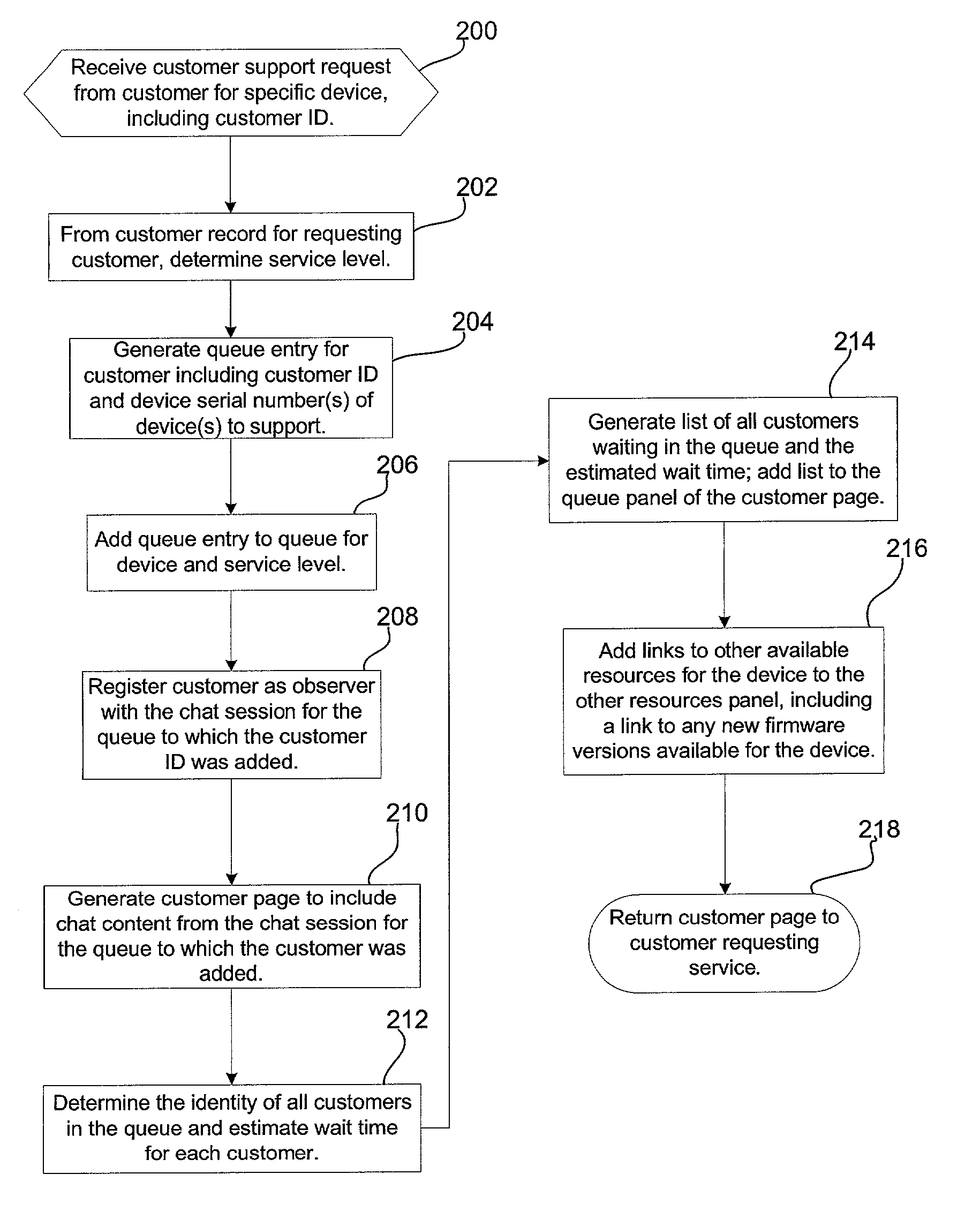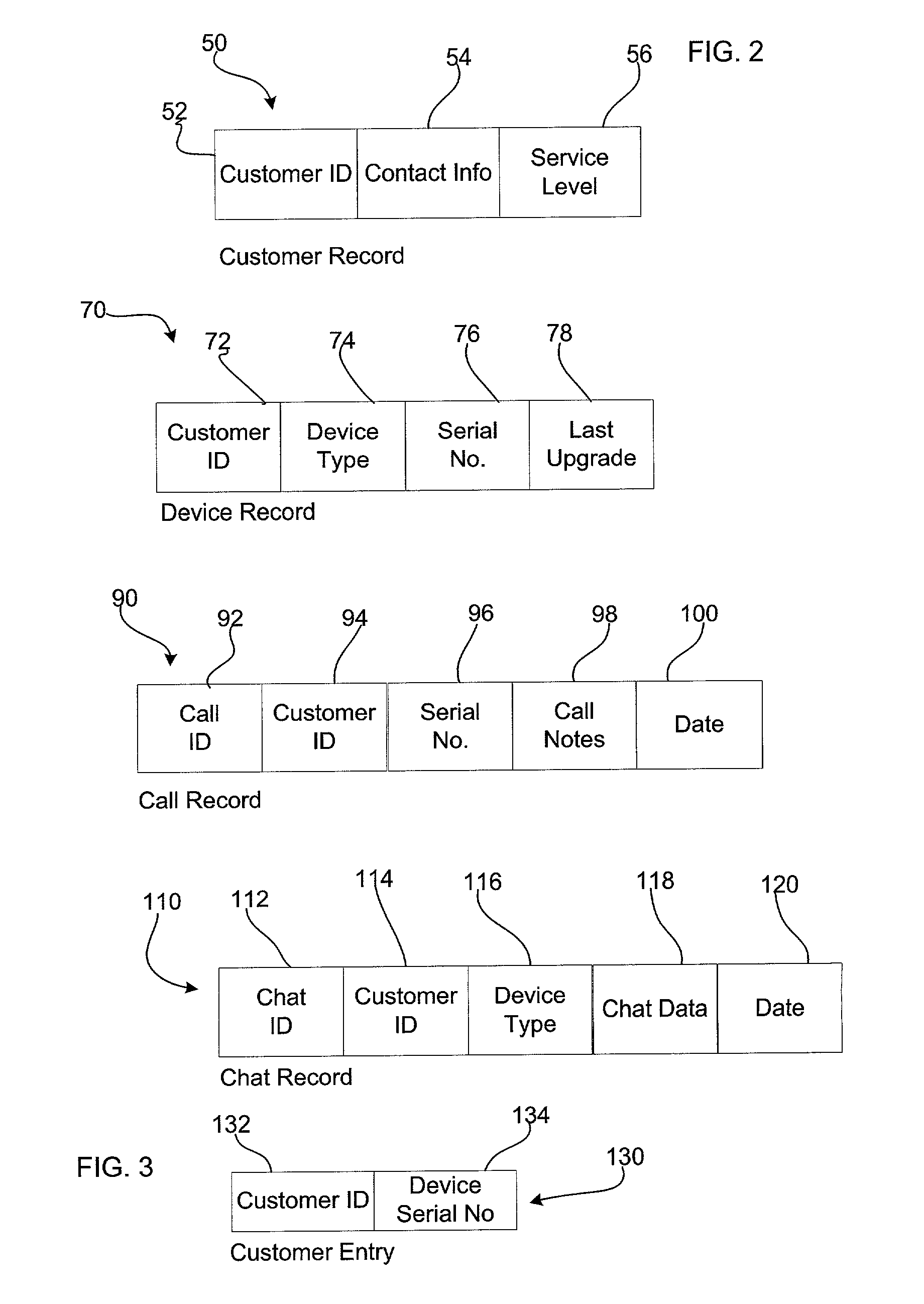[0013] Described implementations concern a
system and
communication interface for providing product support to customers over a
computer network. With the described implementations, customers waiting to speak with a technical support agent are placed in a queue. The queued customers may observe a real-time chat session between one customer in the queue and the technical support agent. In certain implementations, the queued customers as well as technical support agents servicing the queue may access support resources through a page in which the chat session content is also rendered. In this way, customers may observe a potential solution to their problem discussed in the chat session while waiting in the queue. This will allow customers to quit from the queue to implement the solution, thereby reducing wait times for other queued customers and improving overall service.
[0035] The customer would further be registered (at block 208) as a non-participating observer of the chat session 40a . . . 40n associated with the particular queue 32a . . . 32n to which the customer is assigned. Registering the user with a particular chat session 40a . . . 4n causes the chat
server 30 to allow the customer to observe the current chat
stream for the particular chat session 40a . . . 40n. The transaction manager 20 generates (at block 210) a customer page from the customer template 36 to include the chat content from the chat session 40a . . . 40n to which the customer was added. The identity of all the customers queued in the queue 32a . . . 32n to which the customer added is determined (at block 212) and a wait time is estimated. The wait time may be based on an empirically determined wait time per queued customers in general or for a particular product and / or service level. The transaction manager 20 then generates (at block 214) a
list of all the customers waiting in the queue and their corresponding estimated wait time and adds the
list to the queue panel 152 in the customer page 150 (FIG. 4) being generated. Links, such as
hypertext lins, to additional resources, such as a page to access the
search engine 22 to search the knowledge
database 24, a
list of
frequently asked questions, a
firmware upgrade, etc., are then added (at block 216) to the other resources panel 162 in the customer page 150 being generated. The generated customer page 150 is then returned (at block 218) to the customer browser 4a, 4b . . . 4n that initiated the service request. If the page 150 is encoded in
HTML, then the page may include a refresh metatag to cause the customer browser 4a, 4b . . . 4n to reload the page periodically, which would trigger the logic of FIG. 6 to cause the transaction manager 20 to regenerate the page with any updated data. Further, the chat panel 152 enables the customer page 150 to receive real-time chat session 40a . . . 40n content between a customer in the queue 32a . . . 32n and a technical support agent.
[0041] With the above described logic, multiple customers may have their requests added to a queue and receive a customer page 150. The customer page 150 provides an
integrated approach to
customer support, including access to various on-line resources, such as the knowledge
database 24,
firmware upgrades, frequently accessed question documents, technical manuals, etc. Additionally, customers can observe their position in a wait queue to better ascertain when they will be serviced. Alternatively, in certain implementations, only the technical support page 180 may include the wait queue panel 182, and the customer page 150 would not. Yet further, with the described implementations, the customer may observe the chat session in the chat panel 154 between a technical support agent and another queued customer. Providing such real-time chats may provide an opportunity for the customer to observe a solution in the chat panel 154 that is directly applicable to their problem. A customer in the wait queue observing a potential solution in the chat panel 154 may then quit the wait queue 32a . . . 32n and attempt to implement the proposed solution. In this way, customers are serviced from the wait queue without having to communicate with the technical support agent, thereby increasing the number of customers whose problems may be serviced by the technical support agent. The customer page 150 may further include a mechanism to allow a customer to
signal that they are quitting from the queue, which would cause the transaction manager 20 to dequeue the customer from the wait queue 32a . . . 32n and chat session 40a . . . 40n.
[0042] In implementations where wait queues 32a . . . 32n are dedicated to a particular product, the customer problems observed in the chat panel 150 are more likely to be relevant to the problems the queued customers are experiencing. In fact, it has been estimated that 80% of a particular customer's problems are the same problems other customers are experiencing. This percentage may increase if an upgrade to a product is released and numerous customers experience the same problem caused by the upgrade. With the described implementations, the number of technical support agents needed to service customer support requests is minimized because many customer support requests can be serviced from observing solutions discussed in the chat panel 150 or accessed through the other resources panel 162. Customer satisfaction will increase because the number of entries in the wait queues are reduced, thereby reducing the average time a customer must experience before communicating with a technical support agent. Further, customers satisfaction will increase if the customer can implement solutions discussed in the chat panel 154 without having to wait until a technical support agent is available. The described implementations thus utilize the ongoing customer support communications to solve problems for other customers waiting for assistance, thereby reducing customer wait time, the number of customers waiting, and the number of customers that must be serviced directly by a technical support agent.Additional Implementation Details
 Login to View More
Login to View More  Login to View More
Login to View More 


